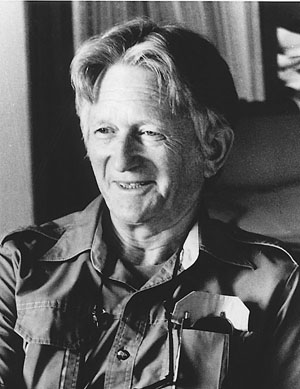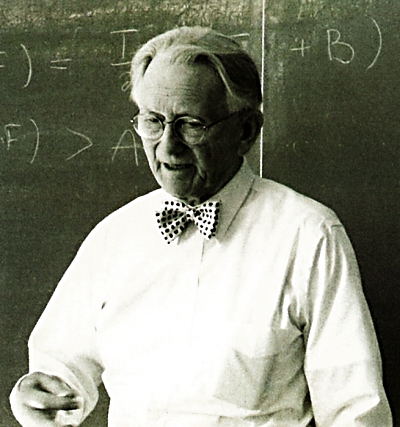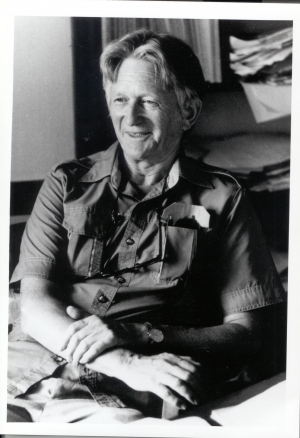Atle Selberg
Atle Selberg ( born June 14, 1917 in Langesund, Norway, † August 6, 2007 in Princeton, New Jersey ) was a Norwegian- American mathematician who won the 1950 Fields Medal for his outstanding work in the field of number theory been.
Life
Selberg's interest in mathematics began as a student. In his youth he read enthusiastically collected publications of S. Ramanujan and began to run his own mathematical research. The next influence came by Erich Hecke, from which in 1936 he heard a lecture at the International Mathematical Conference in Oslo.
He studied mathematics at the University of Oslo to promotion in 1943 and remained there until 1947. During the same year he married Hedvig Liebermann and went to the United States. 1947 to 1948 he worked at the Institute for Advanced Study at Princeton and then moved for a short time at the University of Syracuse. In 1949 he returned as a permanent member to the Institute for Advanced Study and was simultaneously appointed in 1951 as professor of mathematics at Princeton. 1987 Selberg emeritus at Princeton, but without setting his scientific work completely. After the death of his wife Helen in 1995 he married his second wife, the American Betty Compton. According to his family Atle Selberg died at the age of 90 years on 6 August 2007 at his home in Princeton from heart failure. He left behind except his wife Betty a son and a daughter Ingrid Lars first and two stepdaughters from his second marriage. His daughter Ingrid Selberg is a writer, married to a native of Trinidad playwrights Mustapha Matura.
Work
Selberg was initially due to its " elementary " (ie, without using the theory of functions ) proof of the prime number theorem in 1948, almost simultaneously with Paul Erdős, known. The question of mutual influence in the proof, which was created when they were both at Princeton was long disputed. Even in the relative isolation of the war years in Norway, he also proved that at least a small percentage of the non-trivial zeros of the Riemann zeta function on the critical line is ( with real part 1/2) (of Norman Levinson 1974 to 1/3 and Brian Conrey 1989 to 2/5 improved). This was an important step in the still open Riemann 's conjecture field, in front of Hardy and Littlewood had only to show that infinitely many zeros lie on the critical line. In 1947, he improved the screening method of the Norwegian mathematician Viggo Brun in analytic number theory ( Selberg sieve). The trace formula of Selberg (1956 ) was similar to the explicit formulas of analytic number theory, a connection between the sum of the eigenvalues ( the trace ) of the Laplace -Beltrami operator on compact Riemann surfaces and buzz about the geometric range, the lengths of closed geodesic curves ago (the latter assume the role of prime numbers in the corresponding formulas from analytic number theory, while the eigenvalues of the Laplace operator, the zeros of the zeta function, respectively). In this context he also introduced an analogue of the Riemann zeta function, the Selberg zeta - function ( with primes replaced by the lengths of closed geodesic paths ). He also worked on automorphic functions and modular forms ( trace formula of Martin Eichler and Selberg, here the trace of the Hecke operators, Operating as in the space of modular forms ).
Awards
1950 Selberg was at the International Congress of Mathematicians in Harvard awarded the Fields Medal (Presentation: The general sieve method and its place in prime number theory ). In 1962 he gave a plenary lecture at the International Congress of Mathematicians in Stockholm (Discontinuous Groups and Harmonic Analysis). More honors for his work were his memberships in the Norwegian Academy of Science, the Royal Danish Academy of Sciences, the American Academy of Arts and Sciences and the Indian National Science Academy (Indian Academy of Sciences), as well as an honorary member of the London Mathematical Society. 1972 Selberg was awarded an honorary doctorate from the University of Trondheim, 1986 together with Samuel Eilenberg internationally renowned Wolf Prize in Mathematics.
Writings
- Collected Papers. Volume 1: Springer, Heidelberg, 1989, ISBN 3-540-18389-2; Volume 2: Springer, Heidelberg, 1991, ISBN 3-540-50626-8.









